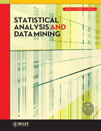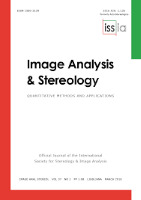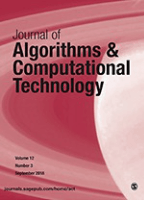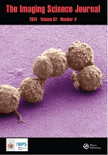
JOURNAL OF CLASSIFICATION
Scope & Guideline
Exploring the Intersection of Theory and Application in Classification
Introduction
Aims and Scopes
- Statistical Classification Methods:
The journal publishes research on diverse statistical methods for classification, including supervised and unsupervised learning techniques. This includes traditional algorithms such as decision trees, support vector machines, and emerging methods like deep learning. - Clustering Algorithms and Techniques:
A significant focus of the journal is on clustering methodologies, exploring novel clustering algorithms, validation techniques, and applications in various domains such as bioinformatics, social networks, and image processing. - Model-Based Approaches:
The journal emphasizes model-based clustering and classification, discussing the theoretical foundations and practical applications of models like finite mixtures, hierarchical models, and Bayesian approaches. - Performance Evaluation and Validation:
Research on metrics and methodologies for evaluating the performance and validity of classifiers and clustering techniques is a key area, ensuring that the results are robust and applicable in real-world scenarios. - Applications of Classification and Clustering:
The journal also highlights applications of classification and clustering in fields like genomics, marketing, and environmental science, demonstrating the practical implications of theoretical advancements.
Trending and Emerging
- Advanced Machine Learning Techniques:
There is a growing emphasis on sophisticated machine learning algorithms, such as multi-task support vector machines and hybrid models that combine various methodologies to improve classification accuracy. - Clustering with Big Data:
Research addressing clustering methodologies specifically designed for big data contexts is on the rise. This includes adaptations of clustering techniques that can handle large-scale datasets, demonstrating the journal's responsiveness to contemporary data challenges. - Feature Selection and Dimensionality Reduction:
A notable trend is the exploration of advanced feature selection and dimensionality reduction techniques that enhance model performance, particularly in high-dimensional settings like genomics and image analysis. - Applications in Emerging Fields:
The journal is increasingly publishing studies that apply classification and clustering techniques to emerging fields such as environmental science, health informatics, and social media analysis, highlighting the relevance of these methods in contemporary research. - Robustness and Interpretability of Models:
There is a rising interest in the robustness and interpretability of classification models, reflecting a broader trend in the statistical community towards ensuring that models are not only accurate but also understandable and reliable.
Declining or Waning
- Traditional Statistical Techniques:
There has been a noticeable shift away from traditional statistical classification methods in favor of more complex machine learning approaches. This indicates a waning interest in simpler models that may not capture the complexity of modern datasets. - Basic Clustering Techniques:
Basic clustering techniques, such as k-means and hierarchical clustering, appear less frequently in recent publications. Researchers are moving towards more sophisticated algorithms that address limitations of these traditional methods. - Generalized Linear Models (GLMs) and Their Variants:
The use of generalized linear models for classification purposes has seen a decline, likely due to the emergence of more effective and flexible machine learning models that can handle high-dimensional data more efficiently.
Similar Journals

JOURNAL OF MATHEMATICAL IMAGING AND VISION
Unveiling the Geometry of Vision through MathematicsJOURNAL OF MATHEMATICAL IMAGING AND VISION, published by Springer, stands as a significant platform for advancing the fields of applied mathematics, computer vision, and pattern recognition, among others. With an ISSN of 0924-9907 and an E-ISSN of 1573-7683, this esteemed journal is based in the Netherlands and has been contributing to the scholarly discourse since its inception in 1992, with a converged focus through 2024. It has achieved reputable standings within several quartiles, including Q2 rankings across applied mathematics, geometry and topology, and condensed matter physics, reflecting its impact and relevance. Notably, the journal ranks within the top 5% in Geometry and Topology and maintains robust standings in Statistics and Probability. The JOURNAL OF MATHEMATICAL IMAGING AND VISION is dedicated to publishing high-quality research that bridges theoretical perspectives with practical applications, making it an essential resource for researchers, professionals, and students who are exploring the cutting-edge of mathematical imaging and its interdisciplinary applications.

Statistical Analysis and Data Mining
Unlocking Insights Through Statistical InnovationStatistical Analysis and Data Mining is a leading journal published by WILEY, dedicated to exploring the latest advancements in statistical methods and data mining techniques. With an ISSN of 1932-1864 and an E-ISSN of 1932-1872, this journal serves as a significant platform for researchers and professionals in statistical analysis, computer science applications, and information systems. Covering a wide range of topics from innovative analytical methodologies to emerging data mining algorithms, the journal aims to disseminate high-quality research that contributes to the evolving landscape of data science. Ranked in the Q2 category for the fields of Analysis, Computer Science Applications, and Information Systems in 2023, it emphasizes its relevance and impact within academia. While it offers limited Open Access options, the insights shared in this publication are integral for those wishing to stay ahead in fast-paced research and data-driven industries. Since its inception in 2008 and continuing through 2024, Statistical Analysis and Data Mining invites submissions that reflect rigorous empirical research coupled with practical implications, making it a vital resource for the academic community.

Journal of Signal Processing Systems for Signal Image and Video Technology
Advancing Innovations in Signal Processing and Imaging.Journal of Signal Processing Systems for Signal Image and Video Technology, published by SPRINGER, is a leading interdisciplinary journal dedicated to advancing research and development in the fields of signal processing, image processing, and video technology. With an ISSN of 1939-8018 and an E-ISSN of 1939-8115, this journal emphasizes both theoretical and practical applications, boasting a wide scope that ranges from control and systems engineering to hardware architecture. Since its inception in 2008, it has gained a solid reputation, reflected in its 2023 category quartile rankings—including Q2 in Control and Systems Engineering and Q3 in Signal Processing—demonstrating its significance within the academic community. The journal is underpinned by a commitment to open access, promoting broad dissemination of knowledge, and is particularly vital for researchers, professionals, and students looking to contribute to and stay updated in these rapidly evolving fields. With ongoing explorations into the convergence of technology and methodology until 2024, the journal stands as a crucial resource for the latest innovations and discussions in signal processing systems.

DATA MINING AND KNOWLEDGE DISCOVERY
Advancing Methodologies for Tomorrow's Data ChallengesDATA MINING AND KNOWLEDGE DISCOVERY, published by Springer, stands as a premier journal within the realms of Computer Networks and Communications, Computer Science Applications, and Information Systems. With an impressive impact factor and a notable presence in various rankings—achieving the Q1 category in 2023—we invite researchers, professionals, and students alike to explore cutting-edge methodologies and innovative applications in data mining. Established in 1997 and continuing its journey through to 2024, the journal not only contributes significantly to the advancement of knowledge in computational techniques but also fosters an understanding of the complex interrelations in data systems. Though not an open access publication, it offers a wealth of insights crucial for driving advancements in technology and analytics. Based in Dordrecht, Netherlands, the journal remains dedicated to disseminating high-quality research and is essential reading for anyone engaged in the ever-evolving field of data science.

NETWORK-COMPUTATION IN NEURAL SYSTEMS
Fostering Collaboration in Network and Neural ComputationNETWORK-COMPUTATION IN NEURAL SYSTEMS is a distinguished journal published by Taylor & Francis Inc, focusing on the innovative intersection of network theory and neural computation. Since its inception in 1990, this journal has provided a vital platform for researchers and professionals in the field of neuroscience, exploring the dynamics of neural networks and computational models. With its current Q3 category ranking in Neuroscience (miscellaneous) and a robust position in Scopus, the journal plays a critical role in advancing knowledge and discussion within this interdisciplinary area. The journal addresses a wide range of topics related to the computational aspects of neural systems, fostering collaboration and providing valuable insights amongst scholars. Although it is not an open-access publication, its well-curated content remains accessible through institutional subscriptions, ensuring that significant research reaches the hands of those who need it. As it continues to evolve through 2024 and beyond, NETWORK-COMPUTATION IN NEURAL SYSTEMS stands as a key resource for anyone deeply engaged in understanding the complexities and intricacies of neural computations.

Image Analysis & Stereology
Unlocking the Potential of Image AnalysisImage Analysis & Stereology is a premier open-access journal dedicated to the dynamic fields of image analysis and stereological methods, published by the International Society for Stereology. Since its inception in 2000, this journal has provided an essential platform for researchers and professionals to disseminate their findings and share innovative methodologies across various disciplines, including Acoustics, Biotechnology, Computer Vision, and Materials Science. As a respected publication with a broad scope, the journal holds a Q3 ranking across multiple categories and is indexed in Scopus. With its commitment to advancing research and enhancing academic discourse, Image Analysis & Stereology is vital for anyone involved in quantitative imaging studies, offering valuable insights and access to groundbreaking research in a rapidly evolving landscape.

Journal of Algorithms & Computational Technology
Advancing the Frontiers of Algorithms and ComputationJournal of Algorithms & Computational Technology, published by SAGE PUBLICATIONS LTD, serves as a noteworthy platform for scholars and practitioners in the realms of applied mathematics, computational mathematics, and numerical analysis. With an ISSN of 1748-3018 and an E-ISSN of 1748-3026, this Open Access journal has been disseminating high-quality research since 2007, ensuring that significant advancements in algorithmic techniques and computational methodologies are readily accessible to the global academic community. Based in the United Kingdom, this journal has steadily established itself within specialized quartiles, notably achieving Q3 ranking in Computational Mathematics and Q4 in both Applied Mathematics and Numerical Analysis for 2023, reflecting its growing influence in these fields. As the journal converges from 2011 to 2024, it aims to cater to the needs of researchers, professionals, and students by publishing innovative research that not only addresses theoretical frameworks but also provides practical applications. By leveraging its open-access model, the Journal of Algorithms & Computational Technology fosters a collaborative environment where knowledge can flourish, allowing for the continuous evolution of algorithms that drive technological advancement.

Wiley Interdisciplinary Reviews-Computational Statistics
Unveiling New Dimensions in Computational StatisticsWiley Interdisciplinary Reviews: Computational Statistics is a leading journal published by WILEY, renowned for its influential contributions to the field of statistics and its application in computational studies. With an impressive impact factor reflected in its 2023 categorization as Q1 in Statistics and Probability, this journal ranks among the top in its category, positioned at 20 out of 278 in Scopus, placing it in the 92nd percentile for its discipline. The journal spans from 2009 to 2024 and offers a rich repository of interdisciplinary insights that encompass both theoretical advancements and practical applications of computational statistics, making it an invaluable resource for researchers, professionals, and students alike. While it does not currently offer open access, the journal's commitment to high-quality, peer-reviewed content ensures that it remains a trusted source for cutting-edge developments and methodologies in the rapidly evolving realm of computational statistics.

IMAGING SCIENCE JOURNAL
Innovating Insights in Computer Vision and MediaImaging Science Journal, published by Taylor & Francis Ltd, serves as a vital resource for researchers and professionals in the fields of computer vision, pattern recognition, and media technology. With an ISSN of 1368-2199 and an E-ISSN of 1743-131X, this journal has been fostering scholarly dialogue since its inception in 1997, with a converged content offering extending through 2024. Its categorization in Quartile 4 in Computer Vision and Pattern Recognition and Quartile 3 in Media Technology highlights its relevance and contributions to emerging trends in these domains. Although it ranks 36th in the Engineering - Media Technology category and 96th in Computer Science - Computer Vision and Pattern Recognition, its innovative research and insights continue to attract the attention of scholars dedicated to advancing knowledge at the intersection of imaging technologies. Offering versatile access options, this journal is essential for students, researchers, and professionals aiming to stay informed and engaged in the rapidly evolving landscape of imaging science.

Data Science and Engineering
Transforming research into real-world impact.Data Science and Engineering is a premier open access journal published by SPRINGERNATURE, dedicated to advancing the fields of data science, artificial intelligence, computational mechanics, and information systems. Since its inception in 2016, this journal has rapidly established itself as a leader in the academic community, boasting an impressive Q1 ranking in multiple computer science categories, including Artificial Intelligence, Software, and Information Systems. With a commitment to disseminating high-quality research, it caters to a diverse audience of researchers, professionals, and students eager to explore the intersection of data and technology. The journal's robust global reach, combined with its respected reputation, empowers authors to share their findings widely, facilitating breakthroughs and innovations across the digital landscape. Join the vibrant community of scholars contributing to this integral field of study, and stay informed with the latest research by accessing the journal freely online.